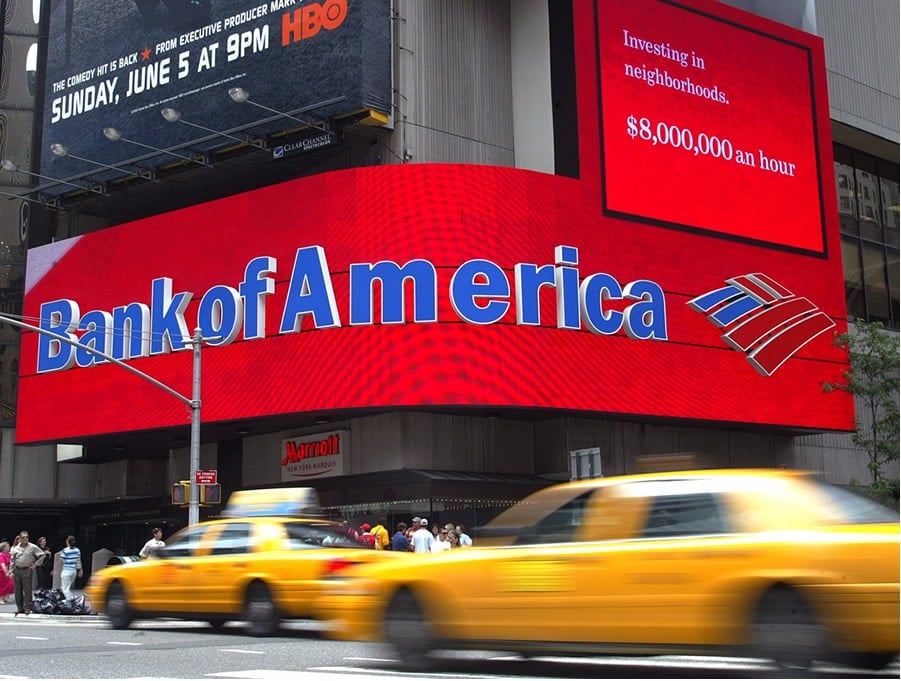US Dollar Rebound "On The Cards" say Bank of America Merrill Lynch

Following months of underperformance, the Dollar is due a recovery against both the Euro and Pound, underpinned by inflows from corporate repatriation flows and rising interest rates.
Broad-based US dollar weakness continues to prevail as the dominant theme on global foreign exchange markets at present with the Dollar index - a measure of overall Dollar strength against a basket of currencies - materially lower (-0.8%) for a fourth consecutive week.
This gives us cumulative decline of 3% with the index approaching 2017 lows seen last September.
But we are told that following months of underperformance, the Dollar is due a recovery, underpinned by inflows from corporate repatriation flows and rising interest rates.
The Dollar, which has been falling ever since the start of 2017, is due a recovery according to a team of Bank of America Merril Lynch foreign exchange analysts.
The team - Kamal Sharma, Ben Randol, and Sophia Salim - have recently put out a foreign exchange guidance note to clients and maintain their view that the Dollar's recent bout of weakness might have gone too far.
It is believed the market is currently too pessimistic about the impact on the Dollar that will result from repatriation flows and tax reforms. The market is also not expecting enough by way of interest rate hikes from the Federal Reserve as a response to the positive impact President Trump's reforms will have on the economy.
"We continue to think the market is ignoring USD upside risks in the first half of the year, while simultaneously over-emphasising the positive and well-priced ECB "normalisation" story," says Sharma.
Initially the Dollar weakened on what the market saw as President Trump's failure to deliver on his growth-orientated fiscal stimulus agenda, but more recently it has fallen as global economies start to see their growth rates accelerate and eclipse that o the US.
This has lead traders to bet interest rates are going to rise at a faster rate at other global central banks than they will at the US Federal Reserve.
However, traders might not fully appreciate that a cocktail of stimulus is about to hit the US economy from a mix of repatriation flows by corporates and lower taxes more widely.
BofA think this will drive up growth and lead the Fed to raise interest rates more aggressively than expected, and higher interest rates are a major FX driver of inflows from international investors seeking the highest returns.
On the subject of repatriation, the debate has see-sawed from those who dismiss their impact due to 90% already being denominated in Dollars and there being no incentive on front-loading repatriation, and others, who see circa 40% denominated in Dollars and some potential impact from flows.
The news that Apple is repatriating $38BN in foreign earnings suggests that rather than wait, corporates may take the opportunity to repatriate now and the US could see inflows, which regardless of the currency denomination, will probably have an inflating effect on the economy, which in turn will push up interest rates and the Dollar.
"Repatriation of accumulated earnings held overseas in local currency by US corporates the result of tax reform passage could result in up to $400bn worth of USD inflows according to our estimates," says BofA.
The other main driver of the expected Dollar rebound will be an adjustment in interest rate expectations, claims BofA.
Currently, the market is only pricing in two rate hikes in 2018, but BofA expects at least 3 and sees a risk of 4.
"The market is pricing about two hikes in 2018 and one in 2019, vs our forecast of three (risk of four) in 2018, followed by three in 2019," says Sharma.
Forecasts for the Dollar Against the Euro and Pound
As a result of the fiscal shot in the arm from increased inflows BofA forecast the Dollar to rebound substantially versus the Euro and as a consequence for EUR/USD to weaken to 1.1500 in H1 from its current level of 1.2230.
The stronger Dollar will also be felt by the Pound with BofA saying the Pound-to-Dollar exchange rate will fall back to 1.26 by March 2018 ahead of a recovery to 1.34 by mid-year.
The exchange rate is forecast to end 2018 at 1.40.
Advertisement
Get up to 5% more foreign exchange by using a specialist provider to get closer to the real market rate and avoid the gaping spreads charged by your bank when providing currency. Learn more here.
